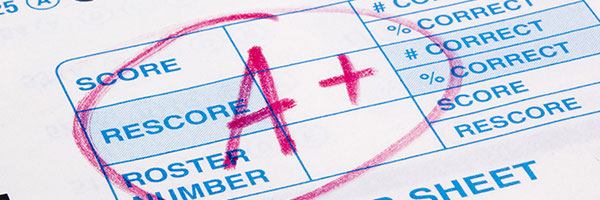Does Chewing Gum affect Memory and Concentration?
Grade 8
Presentation
Problem
Problem:
I wanted to know what are some variables that can change how well a student performs in various tasks through the addition of another variable. So I narrowed it down to two main tests, one for concentration and one for memory. I chose chewing gum as the variable hence the name Does Chewing Gum Affect Memory and Concentration? The reason for this selection will be explained in the research.
Hypothesis:
My hypothesis is that if I give chewing gum to a student and test them for memory and concentration then they will be more focused and alert because of the reduction in stress and anxiety at the moment.
Method
Method:
This project consisted of 16 participants. Every participant filled out the 2C Informed Consent Form and got it signed by their parents. This project was also approved by the CYSF for 2A Ethics and Due Care and was classified as “low risk”.
-The results are anonymous and cannot be traced back to the participants.
-For this to be randomized I created 16 folded slips of paper each with either “A” or “B”. With this I asked every student to pick a random paper. No trading was allowed.
-The chewing gum was handed out to the participants with the letter “A”
-Every test had either "A" or "B"
-The people who had the chewing gum had around one minute to start chewing and wear down their gum.
-The type of gum used was “5 Gum Spearmint Rain Sugarfree Chewing Gum”
-This project is an experimental project
- My experiment consisted of two tests
Concentration Test:
The objective of this test was to find the effect of chewing gum on concentration. Their job was to find the letter “J” in the random assortment of letters as many times as they could in a time limit of one minute.
There were a total of 65 “J” letters in the page.
This tested how concentrated they were and if they found more “J”s that meant they were more focused on their job at that time.
For this test they had one minute
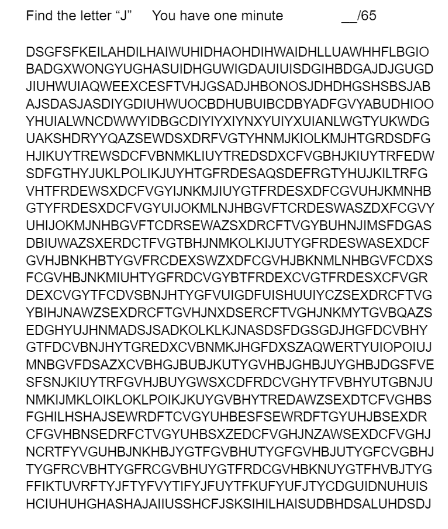
This test was made by typing random letters in a random order and then going over it again to add the letter "J" for 65 times.
Memory Test:
This test was to examine the effect of chewing gum on short term memory. For this test the participants' job was to listen to the numbers I say and when I say “write it down” they had to recall the numbers I said and write it down. Everytime the amount of numbers increased by 1.
This tests the short term memory of them by giving them a number to remember and then testing them on how many numbers they can remember.
The numbers I said are the following
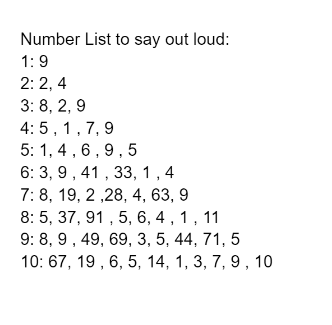
These numbers were randomly selected and after line 5 some of the numbers became two digits.
The materials used were:
-Pencils
-Individually wrapped Chewing Gum 5 Gum Spearmint Chewing Gum
-Test paper
Variables:
Independent Variable
-Chewing Gum, this is the variable that was manipulated between chewing gum and no chewing gum
Dependent Variable
-The Results of the two tests taken, both were quantitative data.
Controlled Variables
-The time and date the test was took
-The same test will be given to everyone
-Same amount of time
-For group “A” , the same type of gum
Research
Selection of Independent Variable:
Whenever me and my family went on long trips, my dad likes to chew gum when he drives because it supposedly keeps him “awake” or “alert”. I decided to test this with my own experiments.
Background Research:
Many recent researches has shown that chewing gum increases concentration and can improve other factors of cognitive function. There have been studies that tested stress, anxiety, attention, memory etc. Many reports have found a significantly higher alertness,contentedness, and calmness (1). One of the earliest studies suggested that sugar-free chewing gum resulted in a significant increase of both immediate and delayed recalling of previous words(2). There was an approximate increase in memory of 30% and in anxiety by 22%(5). Tests such as learning about a new topic or rewriting an essay were used to compare the results between both groups. In one research study they concluded that students with chewing gum were more alert before the lesson compared to those without the chewing gum(1). There was also a comparison between the rate of chewing gum, a fast rate of chewing gum associated with a longer reaction time. More harder chewing was associated with faster solving of new information in their task. Chewing gum before the test was associated with higher level of focus and less errors (3). Another research found that chewing gum increased blood flow to the brain by 25-40%(4).
This shows that chewing gum does have a positive effect on cognitive function in some way.
Numbers in brackets are citations. Please check citations page for them.
Data
There were two tests and I sorted them into A and B. Then I wrote down the student number just to make it easy to keep track of. For the first side (concentration) It was fairly straightforward and I counted how many "J"s they found in the 65 "J"s then I tallied it and counted the total. The backside was a little more complicated because some students did not write commas or space out their numbers so I couldn't decipher if they were trying to say 2 one digits numbers or 1 two digit number. I also tried marking it without taking in consideration the order but then I changed it to the order matters. For example if I said 3 49 9 2 and they wrote 34920 I first looked for the number 3 in their line and then moved on to find the number 49 after 3 and if they had it, it was right. I did this for the rest of the numbers. There were some even more complicated cases where for example I said out loud 7 34 3 7 and they wrote 73927 in this case i first looked for 7 and if it was there I marked it right then i looked for 34 and it wasnt there so they did not get it, next i looked for 3 and there was a 3 but they missed a number in between but I still marked it right because it's still in the right order even though they missed a number. This was done until I got the amount of numbers they found on every line and I added them up to get a score out of 55.
As previously stated, I wrote down a student number for every student so I could create a table with their scores for every paper
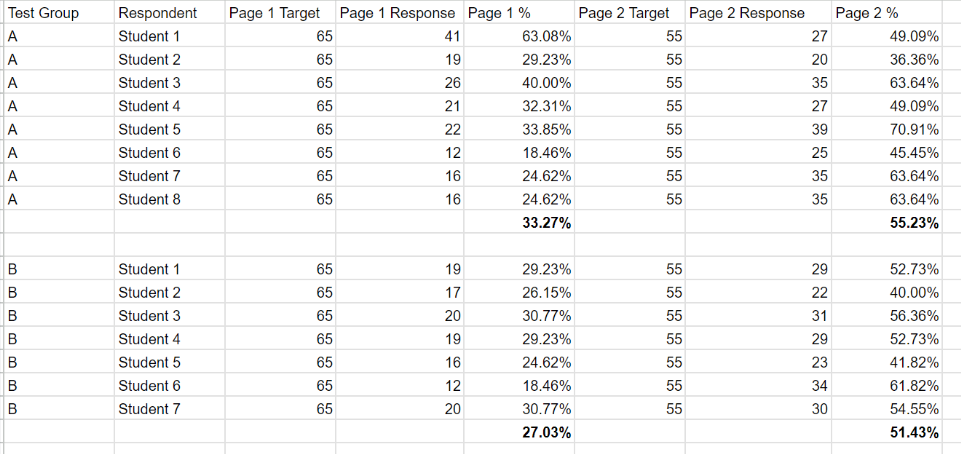
There were 7 participants in group B because one was absent. I started with organizing the papers from students 1 to 8 and then I recorded the amount of "J"s they found in the concentration test and calculated their percentage. Then for page 2 I put the amount of numbers they got out of 55 right and I calculated their percentage. Next I took the average of each group and test.
Conclusion
Simple Conclusion:
The simple conclusion that can be drawn is that chewing gum did have a positive impact on memory and concentration and through the results I have made this simple graph to show it.
This proves my hypothesis was correct as chewing gum did have a positive effect on memory and concentration.
This conclusion is not 100% accurate as it really depends on person to person and how they get affected by chewing gum and one big part is that this test will have to be repeated to get more results to come to a solid conclusion. The sample size would have to be increased also to get a more deeper understanding on how effective the chewing gum is.
Statistical Analysis:
This will give us a more indepth undestanding of the results.
Mean
1) Group A, Page 1:
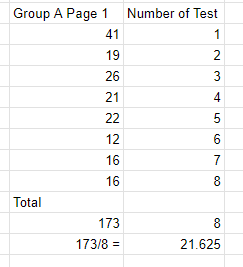
The mean of Group A Page 1 was 21.6 out of the 65 J's
2) Group B, Page 1:
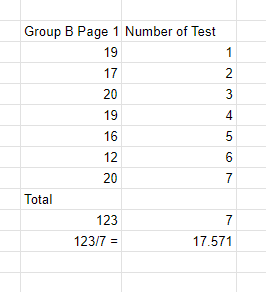
The mean of Group B Page 1 was 17.6 out of the 65 J's
3) Group A, Page 2
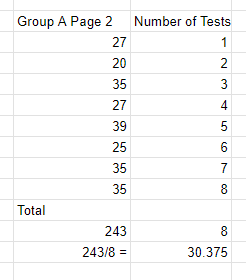
The mean of Group A Page 2 was 30.4 out of the 55 numbers said
4) Group B, Page 2
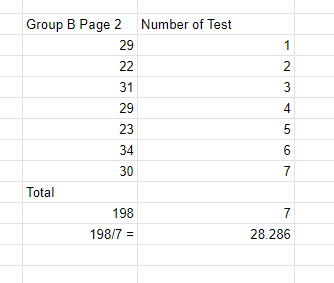
The mean of Group B Page 2 was 28.3 out of the 55 numbers said.
This shows that in both tests there was a increase in the average for chewing gum. For Page 1 there was a 4 number increase which means that Group A on average found 4 more J's than compared to Group B. For the second page there was an approximately a 2 number increase which means that Group A wrote on average of 2 numbers more then group B.
Median:
For the conservation of space I will not include the photos
1) Page 1 Group A : 20
2) Page 1 Group B : 19
3) Page 2 Group A: 31
4)Page 4 Group B: 29
These numbers are very similar which means that there was not a big diffrence in the diffrence in the lowest and highest numbers in each group. For page 1 group a roughly half was below 20 and half was above 20 which compared to group b rougly half was below 19 and half was above 19.
Outliers:
For Page 1, one big outlier was Student Number 1 who got 41 out of 65 J's. This did alter the averages and the median. Here are the averages without the outlier.
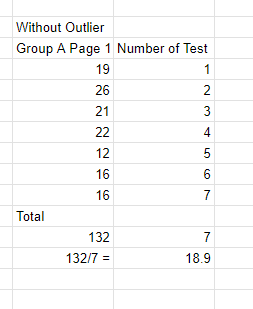
The new mean is 18.9 compared to 21.6 with the outlier. There was a drop of 2.7 because of the outlier. Keeping that in account there is still a diffrence in between the two groups. As group B got 17.6 so this means there is a diffrence of 1.2 which is not as significant. The outlier did have a significant impact on the results.
Future Improvements:
-Run this experiment two or more times
-Possibly incorporate more things to test on such as reaction time, heart rate, stress levels etc
-Give more time for the students to bring back their forms
-Have a larger sample size by giving the forms to more classes
-Consider a longterm memory test rather then short term
Real Life Applications:
Educational Classrooms
-During Class time, students could be allowed to chew gum to potentially enhance their focus and memory.
Test Taking
- People may choose to chew gum while taking a test to increase their alertness
Driving
This may be beneficial to people who drive for a long time because it can prevent drowsiness/sleepiness
Limitations:
Citations
(1) Ginns, Paul & Kim, Theresa & Zervos, Eleni. (2018). Chewing gum while studying: Effects on alertness and test performance. Applied Cognitive Psychology. 33. 10.1002/acp.3467. https://www.researchgate.net/publication/328108486_Chewing_gum_while_studying_Effects_on_alertness_and_test_performance
(2) Lucy Wilkinson, Andrew Scholey, Keith Wesnes, Chewing gum selectively improves aspects of memory in healthy volunteers, Appetite, Volume 38, Issue 3,2002, Pages 235-236,
ISSN 0195-6663, https://doi.org/10.1006/appe.2002.0473. (https://www.sciencedirect.com/science/article/pii/S0195666302904733)
(3) Hindawi Publishing Corporation, BioMed Research International, Volume 2015, Article ID 654806, 16 pages, http://dx.doi.org/10.1155/2015/654806
(4) BITS & PIECES - WHAT TO KNOW ABOUT CHEWING GUM. (n.d.). Parkinson’s Resource Organization. https://www.parkinsonsresource.org/news/articles/bits-and-pieces-what-to-know-about-chewing-gum/
(5) Rajan, U. (2012). Effectiveness of cinnamon chewing gum on memory and anxiety among adolescents at selected seventh day adventist high schools, Andhra Pradesh.
Acknowledgement
I want to express my deepest gratitude towards these individuals who have helped me on this journey,
My parents, who have helped me with anything I needed and gave me encouragement to do this.
Ms.Osicki , for helping me through everystep and never giving up. I couldnt do this without you,
My mentors, Tim Gubski, Princeton University and Irada Shamilova, Juniotech
All the particpants of my study, for taking time out of your day and helping me do this study
These people have tremendously helped me on this project and I can not thank them enough.

